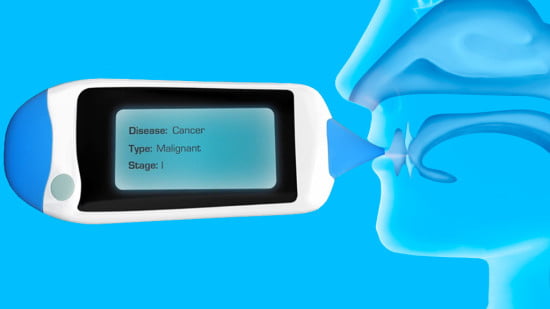Israeli scientists at Ben-Gurion University of the Negev and Soroka University Medical Center in Beersheba announced that they have developed a new non-invasive method to detect early breast cancer more accurately, using commercially available breath and urine tests.
The researchers used two different electronic nose gas sensors for breath, and gas-chromatography mass spectrometry (GC-MS) for urine analysis to “isolate relevant data to more accurately identify breast cancer biomarker,” Ben-Gurion University said in a statement.
According to the findings, published in the May 2018 edition of Computers in Biology and Medicine, the scientists were able to detect breast cancer “with more than 95 percent average accuracy” using an inexpensive electronic nose device (e-nose) that identifies unique breath patterns in affected women. The analyses of urine samples yielded an 85 percent average accuracy, the researchers said.
SEE ALSO: 7 Recent Israeli Breakthroughs In Cancer Research And Detection
Breast cancer is the most commonly diagnosed cancer in women, and affects roughly 1 in 8 women around the world. Mammographies are the most common method to detect breast cancer but the screenings are not 100 percent accurate and may produce false positive as well as false negative results, failing to pick up small tumors in dense breast tissue. Mammography screenings, according to the American Cancer Society, do not detect about 1 in 5 breast cancers.
Other methods to detect cancerous tumors, such as dual-energy digital mammography, and MRIs, can increase radiation exposure and are often expensive, while biopsies and serum biomarker identification processes are “invasive, equipment-intensive and require significant expertise” the researchers indicated.
“Breast cancer survival is strongly tied to the sensitivity of tumor detection; accurate methods for detecting smaller, earlier tumors remains a priority,” said Prof. Yehuda Zeiri, a member of Ben-Gurion University’s Department of Biomedical Engineering, in a statement. “Our new approach utilizing urine and exhaled breath samples, analyzed with inexpensive, commercially available processes, is non-invasive, accessible and may be easily implemented in a variety of settings.”
SEE ALSO: Israeli Biotech Veterans Join Forces To Revolutionize Cancer Diagnosis With New Startup
For the study, breath samples were collected from 48 breast cancer patients, and 45 healthy women who served as a control group. Urine samples were taken from 37 patients diagnosed with breast cancer based on physical or mammography tests prior to any surgery, as well as from 36 healthy women.
“We’ve now shown that inexpensive, commercial electronic noses are sufficient for classifying cancer patients at early stages,” said Prof. Zeiri.
Sign up for our free weekly newsletter
Subscribe“With further study, it may also be possible to analyze exhaled breath and urine samples to identify other cancer types, as well,” he said.
Breath tests used to detect a host of diseases
Developments in breath tests are not new to cancer detection research. Last year, NoCamels reported on the revolutionary research of an international team of 56 of researchers in five countries led by Israeli Professor Hossam Haick of the Technion-Israel Institute of Technology which indicated that different diseases are characterized by different “chemical signatures” identifiable in breath samples.
The study of more than 1,400 patients included 17 different and unrelated diseases: lung cancer, colorectal cancer, head and neck cancer, ovarian cancer, bladder cancer, prostate cancer, kidney cancer, stomach cancer, Crohn’s disease, ulcerative colitis, irritable bowel syndrome, Parkinson’s disease (two types), multiple sclerosis, pulmonary hypertension, preeclampsia and chronic kidney disease.
With new technology called “artificially intelligent nanoarray,” developed by Prof. Haick, the researchers were able to perform fast and inexpensive diagnosis and classification of diseases, based on “smelling” the patient’s breath, and using artificial intelligence to analyze the data obtained from the sensors.
“Each of these diseases is characterized by a unique fingerprint, meaning a different composition of these 13 chemical components,” Prof. Haick explained in a statement at the time. “Just as each of us has a unique fingerprint that distinguishes us from others, each disease has a chemical signature that distinguishes it from other diseases and from a normal state of health. These odor signatures are what enables us to identify the diseases using the technology that we developed.”
Prof. Haick was already well known for the SniffPhone, a device he developed that can sense disease on the breath, much like a breathalyzer test. The SniffPhone uses nanotechnology sensors to analyze the particles on the breath and can pinpoint exact diseases, like certain kinds of cancer, pulmonary and even the early stages of neurodegenerative diseases.
“Breath is an excellent raw material for diagnosis,” said Prof. Haick. “It is available without the need for invasive and unpleasant procedures, it’s not dangerous, and you can sample it again and again if necessary.”
Related posts

Editors’ & Readers’ Choice: 10 Favorite NoCamels Articles

Forward Facing: What Does The Future Hold For Israeli High-Tech?

Impact Innovation: Israeli Startups That Could Shape Our Future





Facebook comments